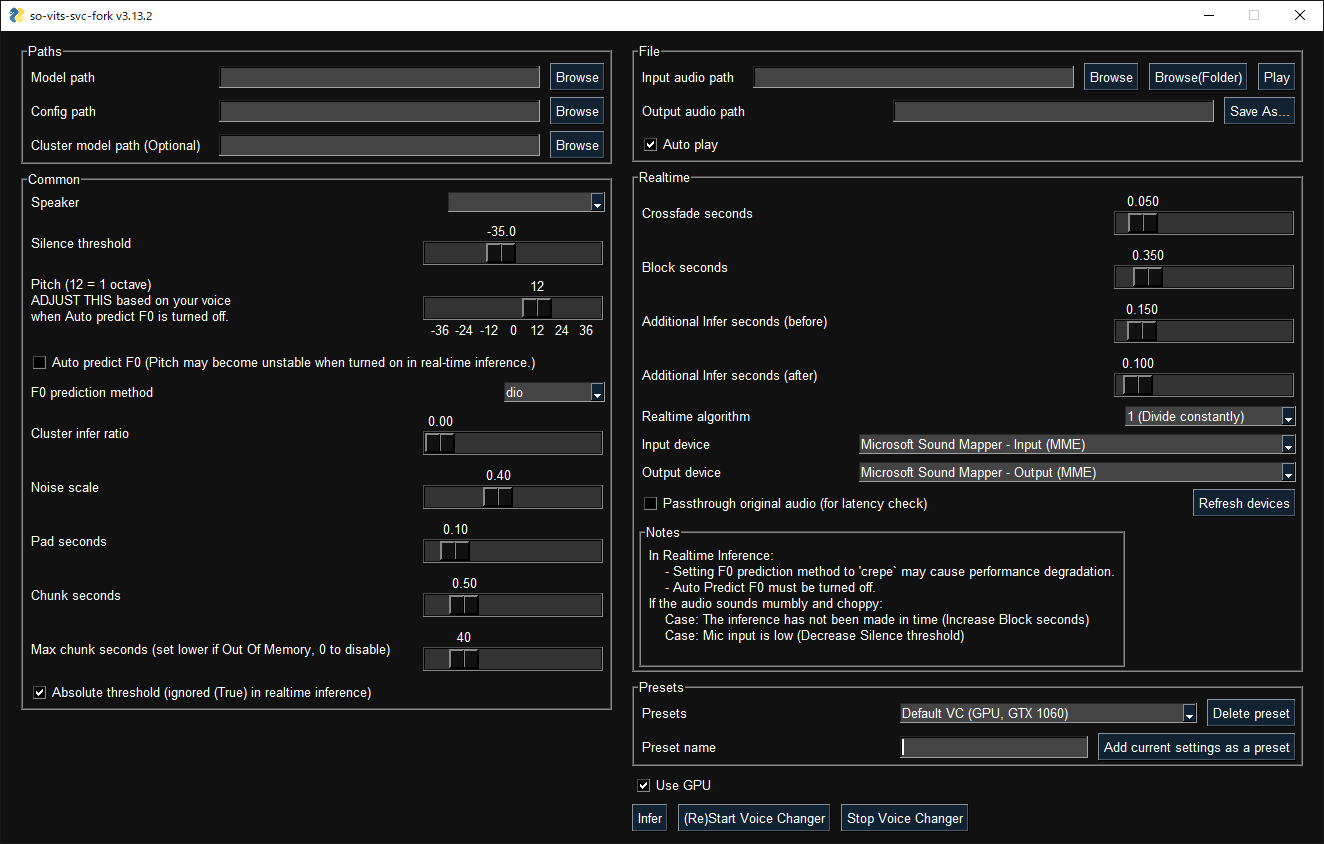A fork of so-vits-svc.
Project description
SoftVC VITS Singing Voice Conversion Fork
A fork of so-vits-svc with realtime support and greatly improved interface. Based on branch 4.0 (v1) and the models are compatible.
Features not available in the original repo
- Realtime voice conversion (enhanced in v1.1.0)
- Integrates
QuickVC - Fixed misuse of
ContentVecin the original repository.^c - More accurate pitch estimation using
CREPE. - GUI and unified CLI available
- ~2x faster training
- Ready to use just by installing with
pip. - Automatically download pretrained models.
- Code completely formatted with black, isort, autoflake etc.
Installation
One click easy installation

Manual installation
Creating a virtual environment
Windows:
py -3.10 -m venv venv
venv\Scripts\activate
Linux/MacOS:
python3.10 -m venv venv
source venv/bin/activate
Anaconda:
conda create -n so-vits-svc-fork python=3.10 pip
conda activate so-vits-svc-fork
Installing without creating a virtual environment may cause a PermissionError if Python is installed in Program Files, etc.
Install this via pip (or your favourite package manager that uses pip):
python -m pip install -U pip setuptools wheel
pip install -U torch torchaudio --index-url https://download.pytorch.org/whl/cu118
pip install -U so-vits-svc-fork
Notes
- If no GPU is available, simply remove
pip install -U torch torchaudio --index-url https://download.pytorch.org/whl/cu118. - If you are using an AMD GPU on Linux, replace
--index-url https://download.pytorch.org/whl/cu118with--index-url https://download.pytorch.org/whl/rocm5.4.2. AMD GPUs are not supported on Windows (#120). - If
fairseqraises an error:- If it prompts
Microsoft C++ Build Toolsis not installed. please install it. - If it prompts that some dll is missing, reinstalling
Microsoft Visual C++ 2022andWindows SDKmay help.
- If it prompts
Update
Please update this package regularly to get the latest features and bug fixes.
pip install -U so-vits-svc-fork
Usage
Inference
GUI
GUI launches with the following command:
svcg
CLI
- Realtime (from microphone)
svc vc
- File
svc infer source.wav
Pretrained models are available on HuggingFace.
Notes
- If using WSL, please note that WSL requires additional setup to handle audio and the GUI will not work without finding an audio device.
- In real-time inference, if there is noise on the inputs, the HuBERT model will react to those as well. Consider using realtime noise reduction applications such as RTX Voice in this case.
Training
Before training
- If your dataset has BGM, please remove the BGM using software such as Ultimate Vocal Remover.
3_HP-Vocal-UVR.pthorUVR-MDX-NET Mainis recommended. ^1 - If your dataset is a long audio file with a single speaker, use
svc pre-splitto split the dataset into multiple files (usinglibrosa). - If your dataset is a long audio file with multiple speakers, use
svc pre-sdto split the dataset into multiple files (usingpyannote.audio). Further manual classification may be necessary due to accuracy issues. If speakers speak with a variety of speech styles, set --min-speakers larger than the actual number of speakers. Due to unresolved dependencies, please installpyannote.audiomanually:pip install pyannote-audio.
Cloud
If you do not have access to a GPU with more than 10 GB of VRAM, the free plan of Google Colab is recommended for light users and the Pro/Growth plan of Paperspace is recommended for heavy users. Conversely, if you have access to a high-end GPU, the use of cloud services is not recommended.
[^p]: If you register a referral code and then add a payment method, you may save about $5 on your first month's monthly billing. Note that both referral rewards are Paperspace credits and not cash. It was a tough decision but inserted because debugging and training the initial model requires a large amount of computing power and the developer is a student.
Local
Place your dataset like dataset_raw/{speaker_id}/**/{wav_file}.{any_format} (subfolders and non-ASCII filenames are acceptable) and run:
svc pre-resample
svc pre-config
svc pre-hubert
svc train -t
Notes
- Dataset audio duration per file should be <~ 10s.
- It is recommended to increase the
batch_sizeas much as possible inconfig.jsonbefore thetraincommand to match the VRAM capacity. Settingbatch_sizetoauto-{init_batch_size}-{max_n_trials}(or simplyauto) will automatically increasebatch_sizeuntil OOM error occurs, but may not be useful in some cases. - To use
CREPE, replacesvc pre-hubertwithsvc pre-hubert -fm crepe. - To use
QuickVC, replacesvc pre-configwithsvc pre-config -t quickvc. - Silence removal and volume normalization are automatically performed (as in the upstream repo) and are not required.
Further help
For more details, run svc -h or svc <subcommand> -h.
> svc -h
Usage: svc [OPTIONS] COMMAND [ARGS]...
so-vits-svc allows any folder structure for training data.
However, the following folder structure is recommended.
When training: dataset_raw/{speaker_name}/**/{wav_name}.{any_format}
When inference: configs/44k/config.json, logs/44k/G_XXXX.pth
If the folder structure is followed, you DO NOT NEED TO SPECIFY model path, config path, etc.
(The latest model will be automatically loaded.)
To train a model, run pre-resample, pre-config, pre-hubert, train.
To infer a model, run infer.
Options:
-h, --help Show this message and exit.
Commands:
clean Clean up files, only useful if you are using the default file structure
infer Inference
onnx Export model to onnx
pre-config Preprocessing part 2: config
pre-hubert Preprocessing part 3: hubert If the HuBERT model is not found, it will be...
pre-resample Preprocessing part 1: resample
pre-sd Speech diarization using pyannote.audio
pre-split Split audio files into multiple files
train Train model If D_0.pth or G_0.pth not found, automatically download from hub.
train-cluster Train k-means clustering
vc Realtime inference from microphone
External Links
Contributors ✨
Thanks goes to these wonderful people (emoji key):
This project follows the all-contributors specification. Contributions of any kind welcome!
Project details
Release history Release notifications | RSS feed
Download files
Download the file for your platform. If you're not sure which to choose, learn more about installing packages.
Source Distribution
Built Distribution
Hashes for so_vits_svc_fork-3.9.2-py3-none-any.whl
| Algorithm | Hash digest | |
|---|---|---|
| SHA256 | 3a9da8f883e512ec8d7c963299c99d09144b1053b63059357d20176c7224cb4d |
|
| MD5 | 2a13bfa8621e548f02c866fe65eca920 |
|
| BLAKE2b-256 | bcca46678406382ca8962abba8b9ce934bc3a9cb4a7cdc809f3199796af529da |








































